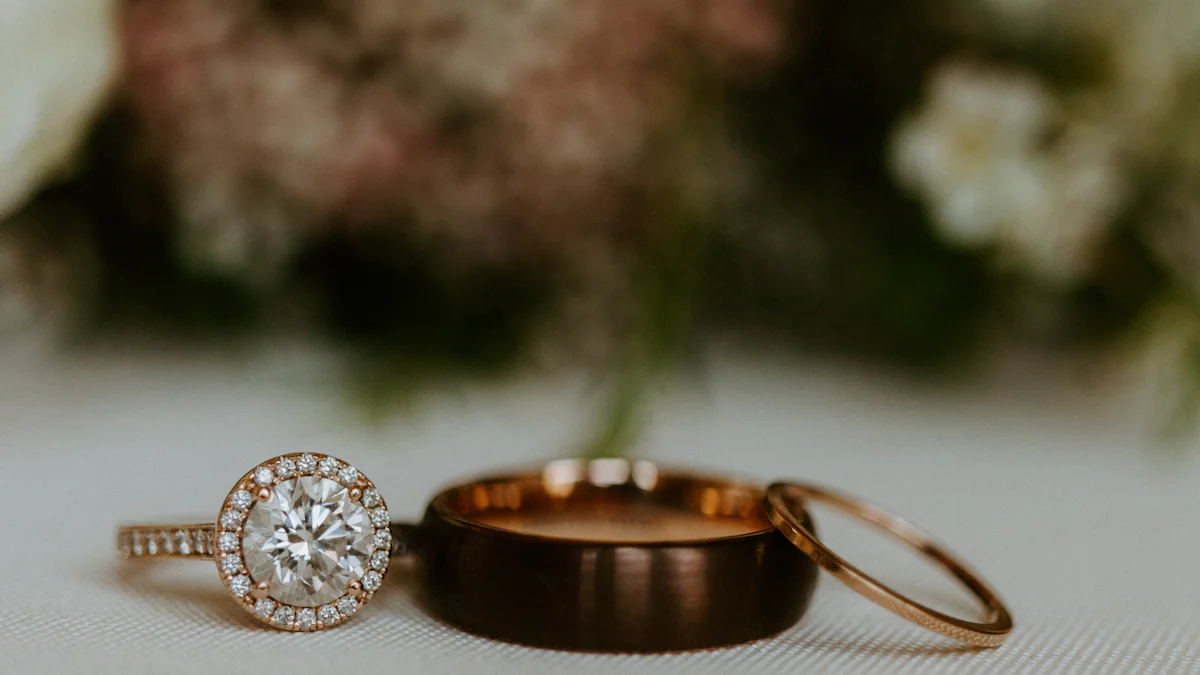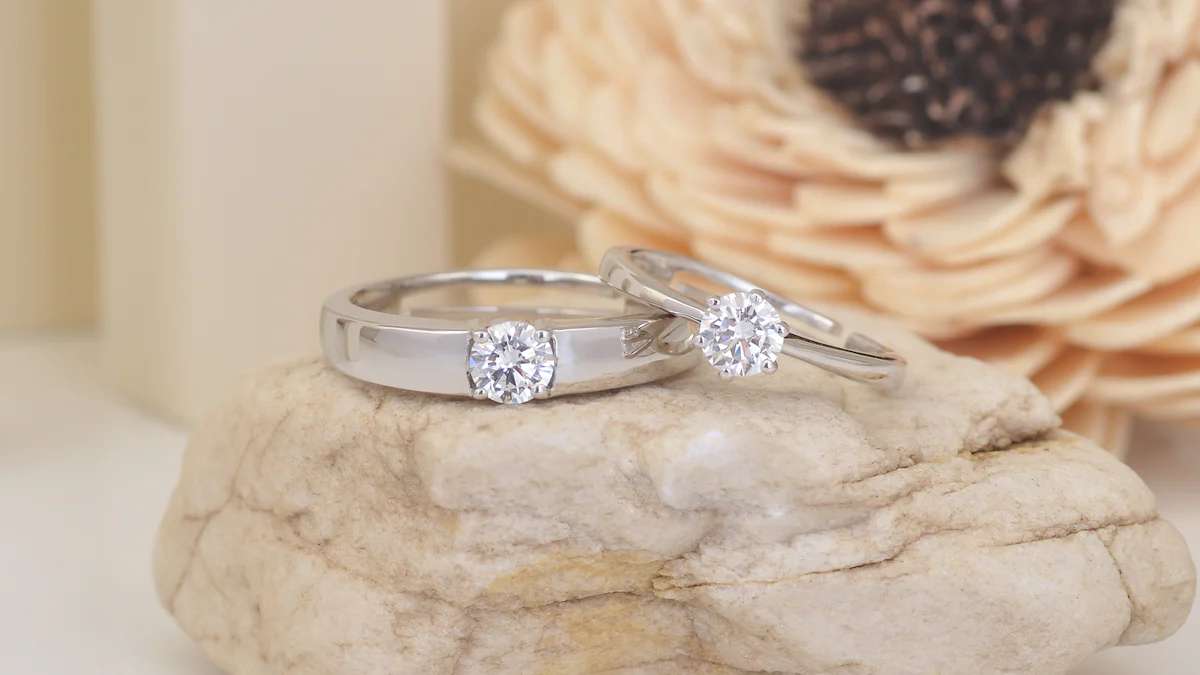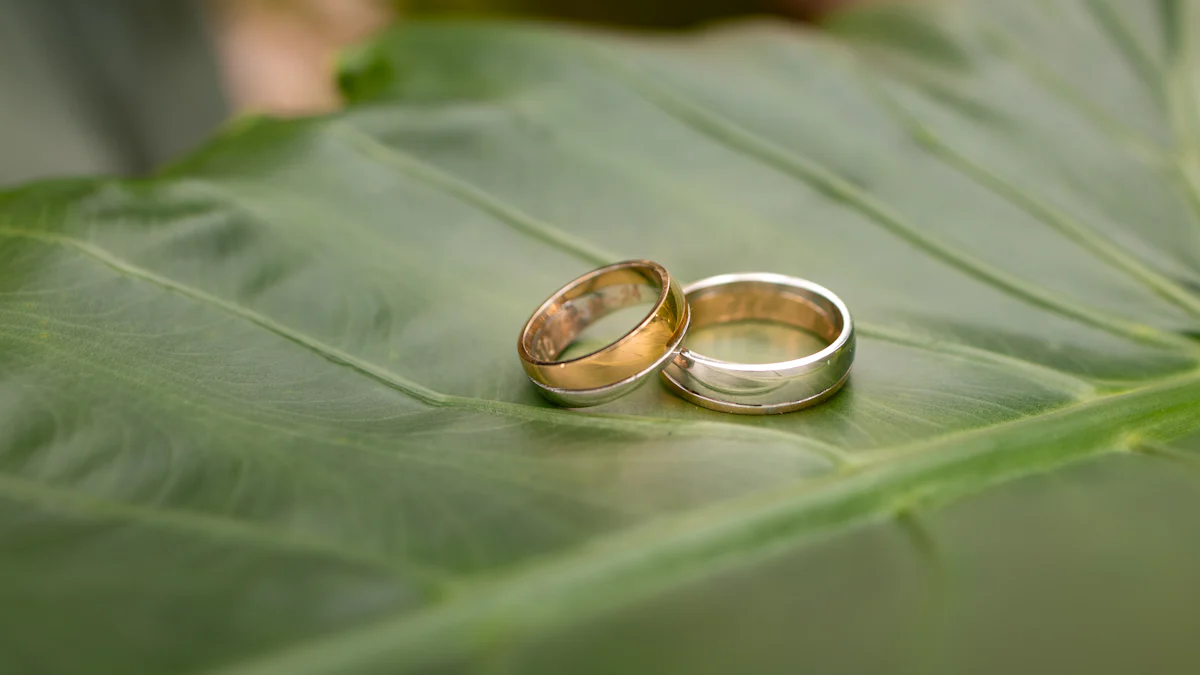What Makes 1950s Wedding Rings Special?

When you think of 1950s wedding rings, you’re stepping into a world of elegance and charm. This era brought a shift toward opulence, with Hollywood’s influence inspiring dazzling designs. Larger diamonds and innovative cuts, like round and marquise, became symbols of love and sophistication. Colored gemstones, such as rubies and sapphires, also gained popularity, reflecting the optimism of post-war prosperity.
Marketing campaigns played a huge role in shaping the appeal of these rings. The iconic slogan “A Diamond is Forever” cemented diamonds as timeless symbols of commitment. With the increased availability of platinum and diamonds after World War II, couples embraced these luxurious materials for their engagement and wedding rings.
Design Characteristics of 1950s Wedding Rings

Popular Styles and Motifs
Mid-century modern influences
The 1950s brought a fresh perspective to wedding ring design, thanks to mid-century modern principles. You’ll notice a shift toward clean lines and simplicity, moving away from the intricate patterns of earlier decades. Early in the decade, rings leaned toward classic feminine styles, but by the late 1950s, geometric and streamlined designs took center stage. This change reflected the era’s cultural focus on individuality.
Post-war prosperity also played a role. With more access to platinum and white gold, jewelers embraced minimalistic aesthetics. Larger diamonds became a hallmark of this period, showcasing the era’s love for bold yet refined elegance.
Floral and nature-inspired designs
Nature-inspired motifs added a touch of romance to 1950s wedding rings. Floral patterns, leaf engravings, and vine-like details were common. These designs captured the optimism of the time, blending vintage charm with modern artistry. If you’re drawn to rings with intricate details, these styles might feel like a perfect fit.
Ring Settings and Shapes
Cluster and halo settings
Cluster and halo settings became iconic during the 1950s. Jewelers often surrounded a large center diamond with smaller stones, creating a dazzling effect. This style wasn’t just about sparkle—it also symbolized unity and togetherness. Tapered baguettes frequently adorned these settings, adding a touch of sophistication.
Geometric and asymmetrical designs
Geometric shapes and asymmetrical designs brought a modern twist to 1950s wedding rings. Solitaires with bold cuts like Asscher, emerald, and marquise gained popularity. These styles reflected the influence of the art deco era, blending vintage aesthetics with contemporary flair.
Influence of Hollywood Glamour
Celebrity-inspired trends
Hollywood stars of the 1950s set the tone for engagement ring trends. Celebrities flaunted extravagant designs featuring larger diamonds and luxurious settings. Grace Kelly’s engagement ring, with its two tapered baguettes, became a symbol of timeless elegance. These celebrity-inspired styles made bold, glamorous rings a must-have for many couples.
The rise of bold and luxurious designs
The post-war economic boom gave couples the means to invest in more luxurious rings. Platinum and diamonds became the materials of choice, reflecting the era’s opulence. Hollywood’s influence encouraged you to dream big, with rings that showcased brilliance and sophistication.
Materials and Craftsmanship

Metals Used in 1950s Wedding Rings
Platinum and white gold as luxury choices
In the 1950s, platinum and white gold became the go-to metals for wedding rings. After World War II, platinum, which had been scarce during the war, became widely available again. This metal’s durability and ability to enhance the brilliance of diamonds made it a favorite for engagement rings. White gold offered a similar sleek look but at a more affordable price. Both metals complemented the era’s love for clean, modern designs and larger center stones, making them perfect for couples seeking timeless elegance.
The growing popularity of yellow gold
While platinum and white gold dominated, yellow gold started gaining traction in the late 1950s. Its warm tone added a vintage charm to wedding rings, appealing to those who wanted a more traditional look. Yellow gold also paired beautifully with intricate details like floral engravings and filigree, giving each ring a unique personality.
Gemstones and Diamond Cuts
Round brilliant and baguette cuts
Diamonds were the star of 1950s wedding rings, and certain cuts stood out. Round brilliant cuts, known for their unmatched sparkle, were incredibly popular. Baguette cuts often flanked the center diamond, adding a touch of sophistication. You’d also find Asscher, emerald, and marquise cuts, which brought a bold, geometric flair to engagement rings.
Colored gemstones for vibrant designs
If you love a pop of color, you’ll appreciate the vibrant gemstones that adorned some 1950s rings. Rubies, sapphires, and emeralds added a playful yet elegant twist to traditional designs. These gemstones often appeared as accents, enhancing the overall style and making each piece feel one-of-a-kind.
Crafting Techniques
Intricate metalwork and filigree
The craftsmanship of 1950s wedding rings was nothing short of extraordinary. Jewelers used intricate techniques like filigree and milgrain detailing to create special details that set each ring apart. These delicate patterns showcased the artistry of the time and added a romantic, vintage touch to every piece.
Advances in rhodium plating and durability
The 1950s also saw advancements in rhodium plating, which gave white gold its bright, reflective finish. This innovation not only enhanced the beauty of engagement rings but also improved their durability. It ensured that your ring could withstand daily wear while maintaining its brilliance for years to come.
Cultural and Historical Context
Post-War Prosperity and Optimism
Economic growth influencing jewelry trends
The 1950s was a time of economic growth and optimism. This prosperity shaped the way couples approached engagement and wedding rings. Diamonds became the ultimate symbol of love and commitment, thanks to clever marketing campaigns. You’ve probably heard the phrase “A Diamond is Forever.” It was during this era that it became iconic, convincing couples that diamonds were timeless and essential for engagement rings.
Jewelry designs reflected the upbeat mood of the post-war years. Retro and Atomic Age styles brought boldness and innovation to 1950s wedding rings. Larger diamonds and elaborate settings became popular, mirroring the glamour of Hollywood. The era’s optimism shone through in every sparkling detail, from traditional cuts to vibrant colored gemstones.
The rise of consumer culture and advertising
Consumer culture boomed in the 1950s, and advertising played a huge role in shaping trends. With more purchasing power, couples sought out extravagant engagement rings. You’ll notice that larger diamonds and luxurious metals like platinum and white gold became more accessible. Advertisements emphasized personalization, encouraging you to choose a ring that felt unique and exclusive.
Hollywood stars also influenced public tastes. Their dazzling rings set the standard for what was fashionable, making bold and brilliant designs the dream for many. Innovations in diamond-cutting techniques added to the appeal, creating eye-catching rings that symbolized love and prosperity.
Marriage and Family Values in the 1950s
Wedding rings as symbols of love and stability
In the 1950s, wedding rings weren’t just beautiful pieces of jewelry. They symbolized love, stability, and commitment. For many, these rings represented the foundation of a strong marriage. The emphasis on traditional family values made engagement and wedding rings even more meaningful.
The emphasis on traditional family roles
The 1950s celebrated traditional family roles, with marriage at the center of it all. Wedding rings became a way to express devotion and uphold these values. When you look at vintage rings from this era, you’ll see how their timeless designs reflect the importance of love and unity.
Influence of Fashion and Media
The role of magazines and TV in shaping trends
Magazines and television were major trendsetters in the 1950s. They showcased the latest jewelry moments of the 1950s, inspiring couples to follow the hottest styles. If you flipped through a magazine back then, you’d find ads featuring glamorous engagement rings, complete with intricate details and sparkling diamonds.
Hollywood’s impact on jewelry design
Hollywood had a massive influence on 1950s wedding rings. Celebrities like Grace Kelly and Elizabeth Taylor wore stunning engagement rings that captured the public’s imagination. Their choices set the tone for what was desirable, making bold and luxurious designs the ultimate goal for many couples. These rings weren’t just jewelry—they were symbols of elegance and sophistication.
Legacy and Modern Appeal of 1950s Wedding Rings
Why 1950s Wedding Rings Are Still Popular
Timeless and versatile designs
The classic designs of 1950s wedding rings have a timeless charm that continues to captivate. These rings feature intricate details and elegant craftsmanship, making them perfect for anyone who loves vintage jewelry. Their versatility allows them to complement both traditional and modern styles effortlessly. Whether you’re drawn to bold geometric cuts or delicate floral motifs, these rings offer something for everyone.
Their enduring appeal lies in their ability to stay relevant across generations. You’ll find that 1950s engagement rings are not just beautiful but also meaningful. They symbolize a significant historical period, reflecting the optimism and prosperity of the post-war era.
Nostalgia for vintage aesthetics
There’s something magical about owning a piece of history. Vintage engagement rings from the 1950s evoke a sense of nostalgia, connecting you to a time of elegance and romance. Their unique designs and high-quality materials make them stand out in a world of mass-produced jewelry. Collectors and enthusiasts appreciate these rings for their sentimental value and historical significance.
Incorporating Vintage Engagement Rings into Modern Styles
Pairing vintage rings with contemporary pieces
Blending vintage and modern styles creates a look that’s both unique and personal. You can pair a 1950s wedding ring with contemporary jewelry to add a touch of vintage flair. For example, a vintage-style engagement ring with a unique twisting diamond braid can beautifully complement a sleek, modern wedding band. This mix of old and new creates a stunning contrast that’s sure to turn heads.
Customizing vintage rings for a modern touch
If you want to make a vintage ring feel more contemporary, customization is the way to go. Adding modern elements like a bezel setting or double prongs can give your ring a fresh look while preserving its vintage charm. Milgrain detailing is another great option. It enhances the classic appeal of the ring while keeping it stylish and relevant.
Collecting and Preserving 1950s Wedding Rings
Tips for finding authentic pieces
Finding authentic 1950s wedding rings requires a bit of research and attention to detail. Start by visiting reputable jewelry stores or vintage boutiques. Online platforms specializing in vintage jewelry can also be great resources. When examining a ring, check for hallmarks or engravings that confirm its authenticity. A professional jeweler can help you assess the quality of the diamond and ensure the design aligns with the era.
Caring for vintage wedding rings
Proper care is essential to preserve the beauty of your vintage ring. Regular cleaning and professional inspections will keep it in top condition. Store your ring in a soft, lined box to prevent scratches. Avoid exposing it to harsh chemicals or wearing it during high-impact activities. These simple steps will ensure your ring remains a cherished heirloom for years to come.
1950s wedding rings capture the elegance and innovation of a remarkable era. Their high-quality materials, like platinum and white gold, showcase durability and luxury. The intricate designs and larger diamonds reflect the artistic expression of the time, making these rings visually captivating and timeless. You’ll find that their bold styles, inspired by Hollywood glamour and mid-century modern trends, continue to influence modern engagement ring designs.
These rings aren’t just jewelry—they’re heirlooms that tell stories. Each piece carries the optimism and affluence of the 1950s, symbolizing love and commitment. Whether you’re drawn to their vintage charm or their cultural significance, 1950s wedding rings remain a source of inspiration and a cherished connection to the past.
FAQ
What makes 1950s wedding rings unique?
1950s wedding rings stand out for their bold designs, intricate craftsmanship, and use of high-quality materials like platinum and white gold. They reflect the optimism of the post-war era and often feature larger diamonds, floral motifs, or geometric shapes inspired by mid-century modern trends.
How can I tell if a wedding ring is from the 1950s?
Look for design elements like cluster settings, baguette accents, or floral engravings. Check for hallmarks or engravings that indicate the era. Visiting a trusted jeweler or vintage expert can help you confirm the ring’s authenticity.
Are 1950s wedding rings durable for daily wear?
Yes! Rings from this era often use durable metals like platinum or white gold. Advances in rhodium plating during the 1950s also improved their longevity. Regular cleaning and proper care will keep your vintage ring looking stunning for years.
Can I customize a 1950s wedding ring?
Absolutely! You can add modern touches like bezel settings or pair it with a contemporary wedding band. Customization lets you preserve the vintage charm while creating a ring that feels uniquely yours.
Where can I find authentic 1950s wedding rings?
Check reputable vintage jewelry stores, estate sales, or online platforms specializing in antique pieces. Always verify authenticity through hallmarks or professional appraisals. A trusted jeweler can guide you in finding a genuine 1950s treasure.
See Also
Discovering Various Styles Of Diamond Wedding Rings
Uncovering Cultural Wedding Ring Traditions Worldwide
The Meaning Behind Wearing Two Wedding Bands

